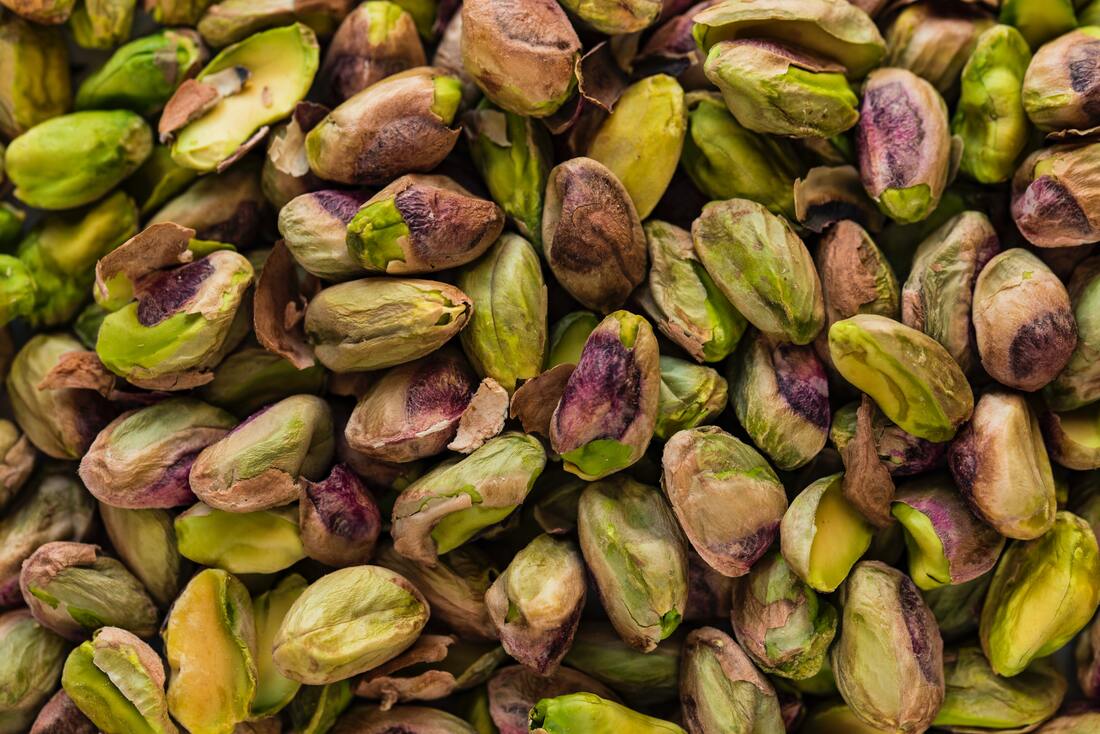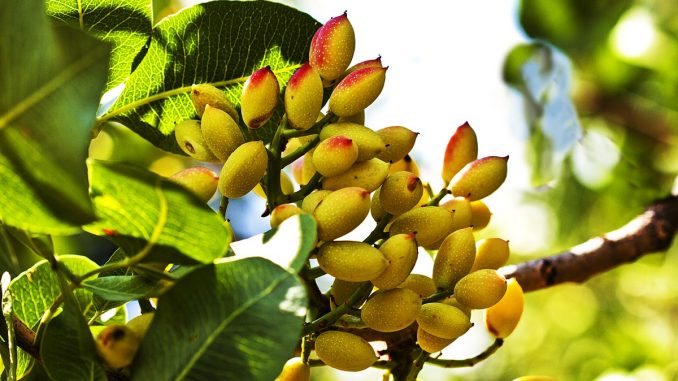|
SEARCH My Blog (Opens in new tab)
Swap snacks for these nuts and watch your weight benefit
Pistachio nuts are often regarded simply as a salty snack - calorie-heavy and salted to tempt you to drink more. That's unfortunate, as there is a lot more to pistachios than just being a great beer snack.
They are one of healthiest nuts that you can eat, along with almonds and walnuts and Brazil nuts. And they can help you better manage your weight. Packed with anti-oxidants - a fantastic healthy snack
Pistachios are known as the colourful nut, but did you know that those bright greens and red-purples come from anti-oxidants?
The green colour comes from carotenes such as lutein and zeaxanthin, purple comes from anthocyanins (also found in high concentrations in blackcurrants, blackberries and blueberries, as well as in aubergine (in the skin), red cabbage, cranberries). Anthocyanins are known for their capacity to lower blood pressure, improve visual acuity, reduce cancer cell proliferation, inhibit tumour formation, prevent diabetes, lower the risk of CVD and to improve cognitive fitness. Although pistachios have it over walnuts in helping eye health, both have been found to support weight loss equally well.
A study compared weight loss participants who consumed pistachios with others who consumed the same number of calories eating pretzel snacks. Those who consumed pistachios maintained a lower Body Mass Index and lowered cholesterol more than those who ate the pretzels.
Here's a simple tip - push those low-nutrient snacks to the back of the cupboard, out of reach, and place pistachios on the bench. Pistachios have a long history as a natural functional food
They are a member of the cashew family. Remains of pistachio nuts dating from about 7,000 years ago are present in both Afghanistan and southeastern Iran. It was widely cultivated in the ancient Persian Empire. Archaeological evidence in Turkey indicates the nuts were being used for food there in that same period.
The Assyrians and the Greeks knew that pistachios are effective as medicines, aphrodisiacs, and antidotes. By the end of his reign, Emperor Tiberius, the Roman consul of the province, introduced pistachios into Italy from Syria.
Subsequently, its cultivation spread to other Mediterranean countries - in southern Europe and North Africa. Around the 10th century, pistachios began to be cultivated in China.
The nuts probably arrived in China via the Silk Road as they were an indispensable form of nourishment for Italian and other European traders travelling to China. In fact, Marco Polo's route took him through Rudbar County in Northern Iran (Persia), an area "abounding in pistachios" (The Travels of Marco Polo / Book 1 / Chapter 19). The Chinese fell in love with the little nuts, and despite their local production, the Chinese import massive quantities. China is now the world's largest importer of pistachios. For a long time, the pistachio remained unknown to the rest of the world, until the 1880s when imported pistachios became popular in the United States of America and Canada due to the arrival of Middle Eastern immigrants. California revealed itself as the perfect location for growing pistachios due to its fertile soil and hot and dry climate. And, as they say, the rest is history. How exactly can you incorporate pistachios into your weight loss food plan?
Nuts are often shunned because people consider them "to be fattening". That's true and false.
One can of Coke (375ml) is certainly fattening, along with zero nutritional benefits and negative health benefits. The equivalent calories in nuts are 4 Brazil nuts, or 20 walnuts, or about 50 pistachio nuts. If you drink many cans of Coke, then it is fattening and has zero nutritional benefits. If you eat a lot of nuts, then you consume many calories but gain dietary benefits. Consuming too much of anything is not a good idea - stick with small portions and in moderation. That said, however, epidemiological studies have failed to find any association between nut or pistachio consumption and either weight gain or an increased risk of obesity (here and here). Packed with goodness, crunchy and slow to digest
Pistachios are rich in unsaturated fats, fibre and anti-oxidants. Research on their anti-oxidant properties dates back to 1942. Research also suggests that pistachios could help to reduce hypertension and promote the development of beneficial gut microbes.
They are a good source of vegetable protein (about 21% of total weight), with an essential amino acid ratio higher than most other commonly consumed nuts (i.e., almonds, walnuts, pecans, and hazelnuts). They have a high percentage of branched-chain amino acids - essential amino acids which help build and repair our muscle tissue.
As the table above shows, among nuts, pistachios have one of the highest level of nutrients that are good for our eyes. Their content of Lutein and Zeaxanthin is over 100 times greater than walnuts (and almonds have none). Caveat: this benefit only comes if you eat the pistachio nut skins as well as the nuts.
Pistachios are more abundant in fibre than other nuts with a 10% by weight of insoluble forms (and 0.3% of soluble forms). Their total carbohydrate proportion is low to moderate (about 29% by weight). When consumed in moderation, pistachios may help control body weight "because of their satiety and satiation effects and their reduced net metabolizable energy content", concluded this research (2012). How does eating pistachio nuts help you lose weight?
The three reasons pistachios can help with your weight control are:
(1) They make you feel more satisfied when you eat them, (2) They consume more energy to be fully absorbed than less fibre-rich foods, and (3) Less of their available energy (calories) is absorbed as they pass through your digestive system and therefore less fat is stored after eating them. If you compare this to a Coke, our body requires zero energy to instantly absorb the 150 calories in a 375ml can. On the other hand, our body burns considerable energy over a long period to extract what it can out of a pistachio nut.
The reason our body needs energy and time to absorb pistachios is because of the energy density of the nuts; their content in fibre, protein, and unsaturated fatty acids; and their crunchy physical structure.
Researchers believe that the crunchy structure also adds to our sensory satisfaction by way of the chewing, the smell and the taste, which makes us feel more satisfied. In addition, the monounsaturated and polyunsaturated fatty acids that nuts contain in general have a high thermic effect - which means that they require our body to use more energy to digest them. Finally, as nuts flow through our digestive system, their fats are malabsorbed to a slight extent - largely because the fat in the walls of nut cells is not completely digested in our gut In other words, calories from the fats in nuts are poorly absorbed - we get the good nutrients without excess calories. This is completely the opposite of what we get by drinking a can of Coke. A Coke is all fizz, fat and no substance, and pistachio all nutrients, little fat, and lots of crunchy fun. Can I eat and enjoy pistachios every day?
Yes, eating pistachios every day is fine. An everyday pistachio serving is about 28 g (1 oz) or 50 kernels - in which there are about 160 calories.
Oddly enough, studies have found that consumption of in-shell pistachios leads to a lower calorie intake than the consumption of kernels. This is simply because of the effort required to shell them. Also, the visual cue of empty pistachio shells seems to help people consume fewer calories during the day. So you might want to leave the shells in the bowl with the nuts. Pistachios are a great addition to many savoury dishes such as pasta, marinades and crusts for meat entrees, salsas, and stir-fries as well as a topping for salads, yogurts, and dips. Their beneficial properties and bioactive molecules will remain unchanged after cooking. If you are looking to lower the glycemic load of a particular meal, then consider adding pistachio nuts. They will slow the absorption of the meal into your blood glucose. While pre-roasted pistachios taste fantastic, you can easily roast them to your own specific taste preference. Shorter roasting times will produce a mild flavour whereas longer times will result in stronger flavours. Here’s how:
To prevent fatty acids in pistachios from oxidation, store them in an airtight container in the refrigerator for up to 1 year. At room temperature (about 20°C), they should be kept in a dry environment and will last several months.
Enjoy a handful of pistachios as a crunchy snack with benefits. Good luck.
> More posts to help you with EXERCISES
> More posts to help you with DIABETES > If you are a @MEDIUM reader my publication Body Age Buster has hundreds of categorised posts which I have written especially for men and women over 50.
PS If you're wondering why pistachios as sold in their shells, unlike most of their nut cousins, it is for purely technical reasons. They can be salted and roasted while still inside the shells - eliminating a step (and cost) in the industrial process.
PSS If you need to shell a whole bunch of pistachios, give this ingenious method a try: BuzzFeed suggests using a spent shell as leverage to pop open the next nut.
Follow me on Quora for more health and fitness tips.
If you valued this article >> Follow me Leave a comment >> Share it >> Stay healthy If you have any questions email me and I will get back to you. Latest: get your free customised fitness plan designed uniquely for you.
|
ChoicesSince I was diagnosed at 50 with Type 2 diabetes I've been learning how to do bone-building fitness training which lowers my age. You can too. It's your choice. Walter Categories
All
Archives
May 2023
|




 RSS Feed
RSS Feed



